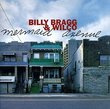| All Artists: Alan Lomax Title: Caribbean Voyage: East Indian Music In The West Indies Members Wishing: 4 Total Copies: 0 Label: Rounder Select Original Release Date: 1/12/1999 Release Date: 1/12/1999 Genres: Blues, Folk, International Music, Pop Styles: Traditional Folk, Caribbean & Cuba, Europe, Continental Europe Number of Discs: 1 SwapaCD Credits: 1 UPC: 011661172326 |
Search - Alan Lomax :: Caribbean Voyage: East Indian Music In The West Indies
 | Alan Lomax Caribbean Voyage: East Indian Music In The West Indies Genres: Blues, Folk, International Music, Pop
In the Fall of '97, Jamaica presented a two-day event on a Kingston fairground, featuring many booths and a main performance stage that showcased the variety, scope, and history of the island's musical and cultural roots. ... more » |
Larger Image |
CD DetailsSynopsis
Amazon.com In the Fall of '97, Jamaica presented a two-day event on a Kingston fairground, featuring many booths and a main performance stage that showcased the variety, scope, and history of the island's musical and cultural roots. The East Indian tent, featuring bhangra players, singers, and dancers, attracted crowds of fascinated Afro-Jamaicans, most of whom were experiencing their compatriots' musical traditions for the first time. Yet East Indians are an integral part of virtually all the Caribbean nations, including Jamaica and especially Trinidad and Tobago, where, today, they outnumber Afro-Trinidadians. Between 1838 and 1917, Asian Indians traveled to the Caribbean as indentured servants, and many stayed beyond their terms of service to put down roots, even become prosperous businesspeople and community leaders. That '97 Jamaican festival and most of the tracks on this 1962 field recording by ethnomusicologist Alan Lomax attest, though, to the strong intracommunal Indo-Caribbean ties that preserved intact the Indian music forms and rituals of their mother culture despite transplantation from Old to New World. "You see the way many people play the Calypso and feel happy," an Indo-Trinidadian man explains to Lomax in a lilting "Trini" accent. "The same way we play this song and feel happy." Yet the revelation of this set is the striking similarities in African and Indian drumming and singing, and, most of all, the African-Indian hybrids that have created new traditions, such as Trinidad's unique Afro-Indian tass drumming and tan singing. --Elena Oumano Similarly Requested CDs
|
CD ReviewsFOR the people, TO the people, BY the people Pharoah S. Wail | Inner Space | 08/06/2003 (4 out of 5 stars) "This is quite an interesting set of recordings. I bought it because of the title alone. I have plenty of Indian musics from India, but not knowing all that much about the West Indies I had no idea that there was/is a sizeable Indian population there. I guess it's strange that my first cd of Indian folk musics ended up being recorded in Trinidad and Guadeloupe. I'm not sure whether this is inherent to all field-recordings of Indian folk music or just this one, but there is indeed almost an African feeling of communal spirit about many of these recordings. Part of me would tend to think that this could just be an aspect of this music because of the geographical location of these people, yet from the liner-notes I also get the feeling that there wasn't a ton of interaction between these Indian communities and the rest of the island cultures. I don't know... maybe it's almost influence-by-osmosis? Or maybe it's just attributable to those island breezes!This is still seriously Indian music, though. If you don't like any sorts of African music you need not worry. This disc gives us work songs, funeral songs, wedding songs, etc...Mainly made up of strains influenced by North Indian musics, but there are also some South Indian tracks. In case you may be wondering, no, this isn't pop music. This is still very much roots-music, it's just that time, distance, and new social settings have caused the music to mutate so that it may not necessarily be all that similar to the musics that initially influenced it. There is a small mix-up in the track listing in the liner-notes. Song 7 is track 5, song 5 is track 6, and song 6 is track 7. All in all, a very rewarding set of recordings. We get various communal drumming styles, vocal-and-harmonium, vocal-and-sarangi, work songs, etc...It's almost refreshing to go from the superhuman world of Indian classical musics to the musics of the everyday people. These are the songs that get people through their lives, whether it be in joy, mourning, work, or celebration. A great, and probably quite rare addition to any collection of Indian musics. This also has one of the best segments of any Lomax recording I have, in terms of hearing him be with the people he is recording. You really get a feel for the type of giving, open person he was."
|

 Track Listings (14) - Disc #1
Track Listings (14) - Disc #1
